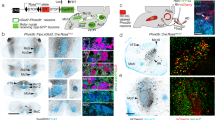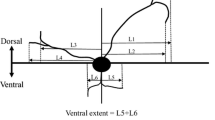Summary
-
1.
In semi-intact preparations food-induced firing patterns in two identified premotor neurons (MA1a and MA2) were explored. During the rhythmic response the membrane potential of the premotor neurons and the jaw motoneurons underwent synchronous depolarization. Then the premotor neurons and the jaw-opening motoneuron started firing almost simultaneously, while the jaw-closing motoneurons started firing after the maximum frequency of the burst of spikes in the premotor neurons.
-
2.
When a large hyperpolarizing current pulse was passed into one of the premotor neurons at the expected time of its burst in order to block its spike activity, the initiation time of firing of the ipsilateral jaw-closing motoneurons was advanced during the cycle, and the slope of the rising phase of the depolarization in the motoneurons became steeper.
-
3.
Repetitive electrical stimulation of the cerebralbuccal connective (c.b.c.) induced rhythmic membrane potential changes similar to those induced by food stimuli in the neurons studied. In the other two premotor neurons (MA1b and MA1c) similar firing patterns to those in MAla and MA2 were induced by c.b.c. stimulation.
-
4.
When a large steady hyperpolarizing current was passed into one of the premotor neurons or when inhibitory effects of the premotor neurons on the jaw-closing motoneurons were removed by d-tubocurarine during the response induced by c.b.c. stimulation, the initiation time of firing of the ipsilateral jaw-closing motoneurons was advanced during each cycle. Moreover, the delay of firing of the jaw-closing motoneurons during each depolarization decreased with an increase in the intensity of hyperpolarizing current.
-
5.
The present findings suggest that during the food-induced response the identified premotor neurons generate the delay of firing of the ipsilateral jaw-closing motoneurons during each depolarization.
Similar content being viewed by others
Abbreviations
- ASW :
-
artificial seawater
- c.b.c. :
-
cerebral-buccal connective
- CPG :
-
central pattern generator
- d-TC :
-
d-tubocurarine
- EPSP :
-
excitatory postsynaptic potential
- I 1, I 3 :
-
intrinsic buccal muscles
- IPSP :
-
inhibitory postsynaptic potential
- JC1–JC3 :
-
jaw-closing motoneurons
- JO1 :
-
jaw-opening motoneuron
- MA1, MA2 :
-
premotor neurons
- n 2, n 3 :
-
buccal nerves 2, 3
References
Audesirk TE, Audesirk GJ (1979) Oral mechanoreceptors in Tritonia diomedea. II. Role of feeding. J Comp Physiol 130:79–86
Benjamin PR (1983) Gastropod feeding: behavioral and neural analysis of a complex multicomponent system. In: Roberts A, Roberts BL (eds) Neural origin of rhythmic movements. Symp Soc Exp Biol. Cambridge Univ Press, Cambridge, pp 159–193
Benjamin PR, Rose RM (1979) Central generation of bursting in the feeding system of the snail, Lymnaea stagnalis. J Exp Biol 80:93–118
Benjamin PR, Rose RM (1980) Interneuronal circuitry underlying cyclical feeding in gastropod molluscs. Trends Neurosci 3:272–274
Croll RP, Davis WJ (1982) Motor program switching in Pleurobranchaea. II. Ingestion and egestion in the reduced preparation. J Comp Physiol 147:143–154
Delcomyn F (1980) Neural basis of rhythmic behavior in animals. Science 210:492–498
Elliott CJH, Benjamin PR (1985a) Interactions of pattern-generating interneurons controlling feeding in Lymnaea stagnalis. J Neurophysiol 54:1396–1411
Elliott CJH, Benjamin PR (1985b) Interactions of the oscillator interneuron with feeding pattern-generating interneurons in Lymnaea stagnalis. J Neurophysiol 54:1412–1421
Fentress JC (ed) (1975) Simpler networks and behavior. Arnold, London
Getting PA (1988) Comparative analysis of invertebrate central pattern generators. In: Cohen AH, Rossignol S, Grillner S (eds) Neural control of rhythmic movements in vertebrates. Wiley, New York, pp 101–127
Howells HH (1942) The structure and function of the alimentary canal of Aplysia punctata. Q J Microsc Sci 83:357–397
Jahan-Parwar B, Wilson AH JR, Fredman SM (1983) Role of proprioceptive reflexes in control of feeding muscles of Aplysia. J Neurophysiol 49:1469–1480
Koch UT, Koester J, Weiss KR (1984) Neural mediation of cardiovascular effects of food arousal in Aplysia. J Neurophysiol 51:126–135
Kupfermann I (1974) Feeding behavior in Aplysia: a simple system for the study of motivation. Behav Biol 10:1–26
Kupfermann I, Cohen J (1971) The control of feeding by identified neurons in the buccal ganglion of Aplysia. Am Zool 11:667
McClellan AD (1982) Movements and motor patterns of the buccal mass of Pleurobranchaea during feeding, regurgitation and rejection. J Exp Biol 98:195–211
Nagahama T, Takata M (1987) Food-induced firing patterns in motoneurons innervating the pharynx of Aplysia kurodai. J Comp Physiol A 161:799–809
Nagahama T, Takata M (1988) Food-induced firing patterns in motoneurons producing jaw movements in Aplysia kurodai. J Comp Physiol A 162:729–738
Nagahama T, Takata M (1990) Neural mechanism generating firing patterns in jaw motoneurons during the food-induced response in Aplysia kurodai. I. Identification and characterization of premotor neurons. J Comp Physiol A 166:143–150
Roberts A, Roberts BL (eds) (1983) Neural origin of rhythmic movements. Symp Soc Exp Biol. Cambridge Univ Press, Cambridge
Rose RM (1972) Burst activity of the buccal ganglion of Aplysia depilans. J Exp Biol 56:735–754
Rose RM, Benjamin PR (1979) The relationship of the central motor pattern to the feeding cycle of Lymnaea stagnalis. J Exp Biol 80:137–163
Rose RM, Benjamin PR (1981a) Interneuronal control of feeding in the pond snail Lymnaea stagnalis. I. Initiation of feeding cycles by a single buccal interneuron. J Exp Biol 92:187–201
Rose RM, Benjamin PR (1981b) Interneuronal control of feeding in the pond snail Lymnaea stagnalis. II. The interneuronal mechanism generating feeding cycles. J Exp Biol 92:203–228
Rosen SC, Weiss KR, Cohen JL, Kupfermann I (1982) Interganglionic cerebral-buccal mechanoafferents of Aplysia: receptive fields and synaptic connections of different classes of neurons involved in feeding behavior. J Neurophysiol 48:271–288
Susswein AJ, Weiss KR, Kupfermann I (1978) The effects of food arousal on the latency of biting in Aplysia. J Comp Physiol 123:31–41
Usherwood PNR, Newth DR (eds) (1975) ‘Simple’ nervous systems. Edward Arnold, London
Weiss KR, Chiel HJ, Koch U, Kupfermann I (1986) Activity of an identified histaminergic neuron, and its possible role in arousal of feeding behavior in semi-intact Aplysia. J Neurosci 6:2403–2415
Author information
Authors and Affiliations
Rights and permissions
About this article
Cite this article
Nagahama, T., Takata, M. Neural mechanism generating firing patterns in jaw motoneurons during the food-induced response in Aplysia kurodai . J Comp Physiol A 166, 277–286 (1990). https://doi.org/10.1007/BF00204802
Accepted:
Issue Date:
DOI: https://doi.org/10.1007/BF00204802




